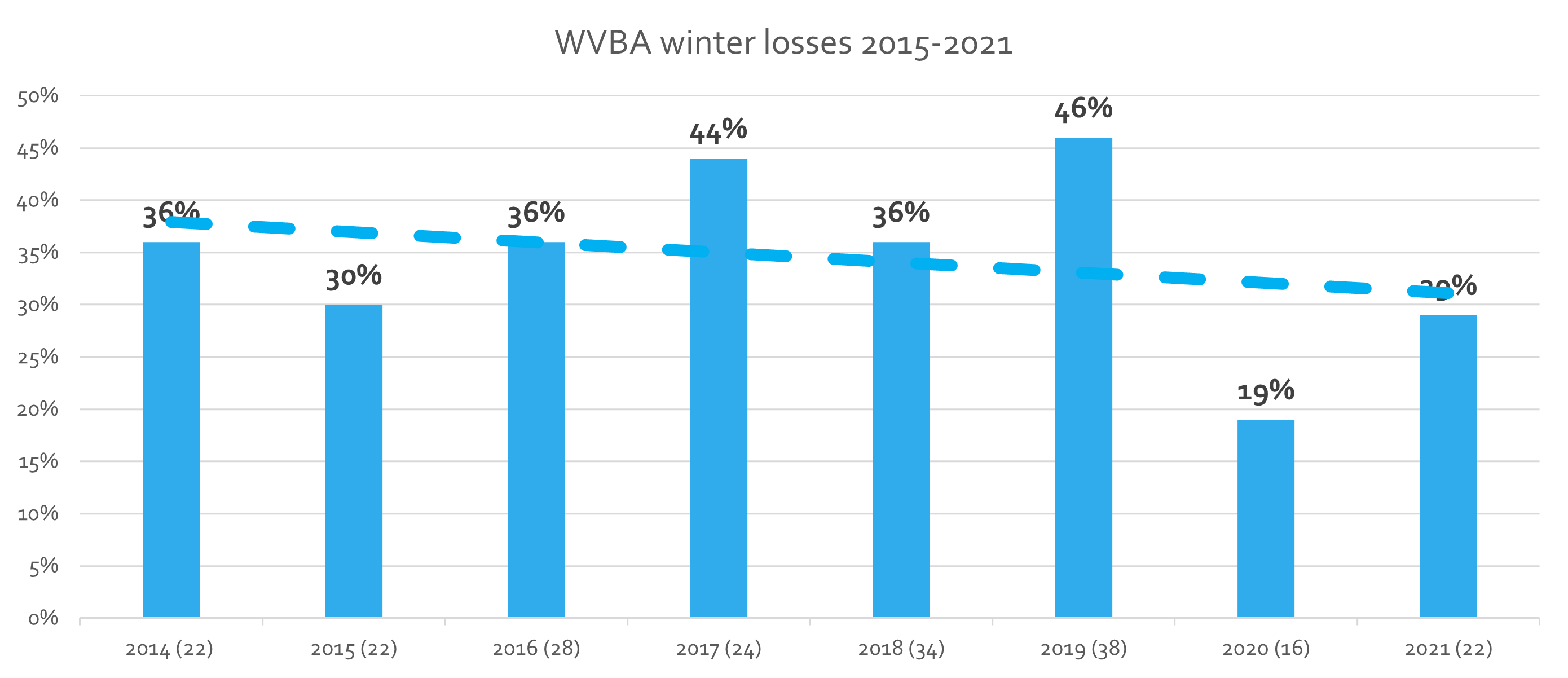The PNW honey bee survey is now open, extending to end of April. Survey can be completed in only 5-10 minutes. Go to: https://pnwhoneybeesurvey.com/survey To examine past survey results look for WVBA survey report on same site under survey results. I ASK WVBA members to complete a survey again this year.
Last year, the 22 WVBA survey respondents (168 fall colonies) reported a 29% loss, second best survival of all the bee clubs; statewide average loss was 35%. The level is 6 percentage points below the WVBA average loss level of previous seven years (35%) and 11 percentage points below Oregon statewide 12-year average (40%). See graphic. The trend line is for an increasingly successful wintering.
WVBA member respondent percent losses, determined by hive types, were 29% for both Langstroth 8 and 10 frames hives (= 86% of total number of hives) and 21% loss of nucs (only 14 reported as fall units by respondents). Of 6 top bar hives, 3 were lost, a single Warré hive was lost, and a single Styrofoam hive survived. The members reported 14% loss of previously overwintered colonies, a heavy 75% loss of the 8 packages, while nuc (53%) and swarm (44%) losses were intermediate. Only 9% of 35 splits failed to survive.
Not everyone had loss. Three individuals (36 colonies) had total survival. Seven WVBA individuals (32%) reported total colony loss (12 colonies total). Heaviest loss was of one colony. Atypical of the statewide data, WVBA respondents colony ownership skewed toward 10 or more colonies (7 individuals). No first-year beekeepers sent in a survey. Individuals keeping 6 or 7 colonies (3 members) had 11% loss, 5 individuals keeping 10-18 colonies had a 14% loss while 2 individuals each with more than 25 colonies experienced a 43% loss. In contrast as colony count increases the percent colony loss decreases statewide. Only 3 respondents reported keeping bees more than 10 years.
The survey asks about basic managements of feeding, winterizing and sanitation and computes survival for each of the various options. Number of returns for WVBA are small this year so looking at statewide management survey returns is perhaps more representative. The analysis of club managements was performed on 21 of the 22 respondents. The individual with the greatest losses (68%) was an outlier – data was included in statewide analysis (328 individuals) but not in the club report.
Overall, loss of the 21 individuals was 22%. It should be emphasized that these comparisons are correlations not causation. They are single comparisons of one item with loss numbers. WVBA beekeepers do not necessarily do only one management nor do they necessarily do the same thing to all the colonies in their care.
In my analysis, feeding colonies helped WVBA beekeepers to reduce losses. The 21 WVBA survey respondents (minus the one with large loss) checked 59 feeding options = 3/individual (statewide it was 2.9/individual). One individual indicated no feeding (had 1 colony) and lost it = 100% loss. Four individuals selected a single choice (sugar syrup) and had 29% loss. Four individuals indicated 2 feeding selections and had 35% loss (2 selected pollen patty and sugar syrup (33% loss), 1 pollen patty and honey (22% loss) and the 4th selected sugar syrup and hard candy (100% loss). Six individuals indicated 3 choices (19% loss), five of which combined pollen patty, sugar syrup with dry or hard sugar candy. Six had 4 selections and 1 had 5 choices – they had a 19% loss. Feeding choices helped decrease loss and improve survival.
Statewide for the last 5 years (average loss rate = 41%), the 8% of individuals doing no feeding had 6 percentage point higher losses (average 47%) i.e. poorer survival. Individuals statewide that fed sugar syrup had a 6-percentage point lower loss level (average for the 5 years); for WVBA, sugar syrup feeders had a 6-percentage point improvement in survival. Those feeding honey (as frames or liquid) had lower loss only during 2 of the past 5 years. Individuals feeding non–liquid sugar (in any of the forms) had lower losses four of five past winter seasons, including WVBA members this past winter.
For individuals feeding protein, only the protein patty users showed better survival all 5 years; dry pollen feeders had much better survival in two of the past five years but loss levels were similar to the overall yearly average.
The survey results are available at pnwhoneybeesurvey.com/ (under survey results, individual club reports). WVBA responding members are doing a good job in keeping losses reduced. Please consider sending in a survey for this past winter. Your cooperation is appreciated. I will be discussing the results at club meeting and in a 2022 report.
